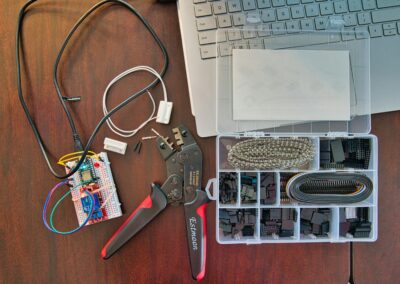Understanding the Challenges of Ensuring Firmware Security in IoT Deployments
Complexity of Diverse IoT Ecosystems
Ensuring firmware security in IoT deployments is a multifaceted challenge, primarily due to the complexity of managing diverse IoT ecosystems. In technologically advanced regions like Saudi Arabia and the UAE, businesses deploy a wide range of IoT devices from different manufacturers, each with unique firmware and security requirements. For instance, a smart city project in Riyadh may involve integrating various sensors, cameras, and communication devices, all of which need secure firmware updates. The diversity in device types and firmware standards makes it challenging to implement uniform security measures, thereby increasing the risk of vulnerabilities and cyber-attacks.
Frequent Updates and Patches
Another significant challenge in firmware security in IoT deployments is managing frequent updates and patches. IoT devices, by their nature, require regular firmware updates to fix security vulnerabilities and enhance functionality. However, ensuring that all devices receive timely updates can be a daunting task, especially for large-scale deployments. In the UAE, where smart infrastructure is rapidly expanding, maintaining the security of these devices through regular updates is crucial. Delays in applying patches can leave devices exposed to potential threats, making it essential for businesses to implement efficient update management systems that ensure all devices are promptly updated with the latest security patches.
Resource Constraints
Resource constraints are a critical factor that complicates firmware security in IoT deployments. Many IoT devices have limited processing power, memory, and storage, which can hinder the implementation of robust security measures. For example, in Dubai, where IoT is extensively used in logistics and transportation, devices such as GPS trackers and sensors need to operate efficiently while maintaining security. The challenge lies in balancing the resource requirements for performing essential functions and running security protocols. This constraint necessitates the development of lightweight security solutions that can operate effectively within the limited resources of IoT devices.
Solutions to Overcome Firmware Security Challenges in IoT Deployments
Adopting Secure Boot Mechanisms
One effective solution to address firmware security in IoT deployments is adopting secure boot mechanisms. Secure boot ensures that a device only runs firmware that is trusted and authenticated, preventing malicious code from being executed during the boot process. In Saudi Arabia, where securing critical infrastructure is a priority, implementing secure boot mechanisms can significantly enhance the security of IoT devices. For instance, an energy company in Riyadh can deploy IoT devices with secure boot capabilities to ensure that only verified firmware is loaded, protecting the devices from unauthorized modifications and attacks. This approach helps maintain the integrity and security of the IoT ecosystem.
Implementing Over-the-Air (OTA) Updates
Implementing Over-the-Air (OTA) updates is another crucial strategy for ensuring firmware security in IoT deployments. OTA updates allow businesses to remotely deploy firmware updates to IoT devices, ensuring that all devices receive the latest security patches without manual intervention. In the UAE, where smart city projects involve thousands of IoT devices, OTA updates provide an efficient way to manage firmware security. For example, a smart transportation system in Dubai can use OTA updates to ensure that all connected vehicles receive timely security patches, reducing the risk of vulnerabilities. This method not only streamlines the update process but also ensures that all devices remain secure and up-to-date.
Utilizing Lightweight Security Protocols
To address resource constraints, businesses can utilize lightweight security protocols that are specifically designed for IoT devices. These protocols provide robust security while operating efficiently within the limited resources of IoT devices. In regions like Saudi Arabia and the UAE, where IoT devices are deployed in various sectors, adopting lightweight security protocols can enhance the overall security of the IoT ecosystem. For instance, an agricultural enterprise in Riyadh using IoT sensors for monitoring crop conditions can implement lightweight encryption and authentication protocols to protect data integrity and prevent unauthorized access. By leveraging these specialized protocols, businesses can ensure that their IoT devices remain secure without compromising performance.
Conclusion
Ensuring firmware security in IoT deployments presents several challenges, including managing diverse IoT ecosystems, frequent updates, and resource constraints. However, by adopting secure boot mechanisms, implementing OTA updates, and utilizing lightweight security protocols, businesses in Saudi Arabia and the UAE can effectively overcome these challenges. These solutions not only enhance the security of IoT devices but also improve the overall efficiency and reliability of IoT deployments. As the adoption of IoT technology continues to grow, prioritizing firmware security will be crucial for businesses to protect their investments and ensure the integrity of their IoT ecosystems. By addressing these challenges proactively, businesses can leverage the full potential of IoT technology while maintaining robust security standards.
—
#FirmwareSecurity #IoTSecurityChallenges #IoTDeployments #SmartTechnology #BusinessEfficiency #ModernIoTSolutions #Cybersecurity #SaudiArabia #UAE #Riyadh #Dubai
































